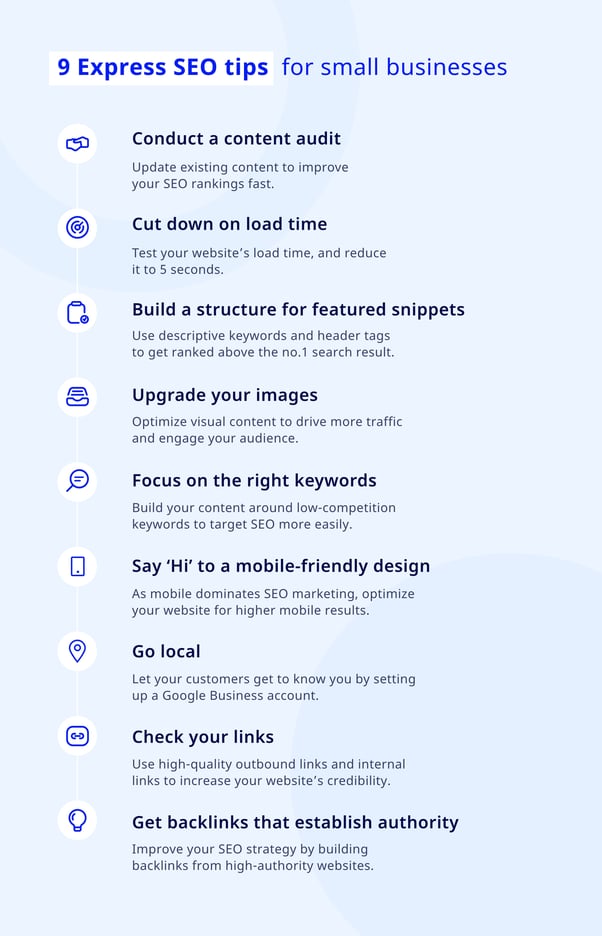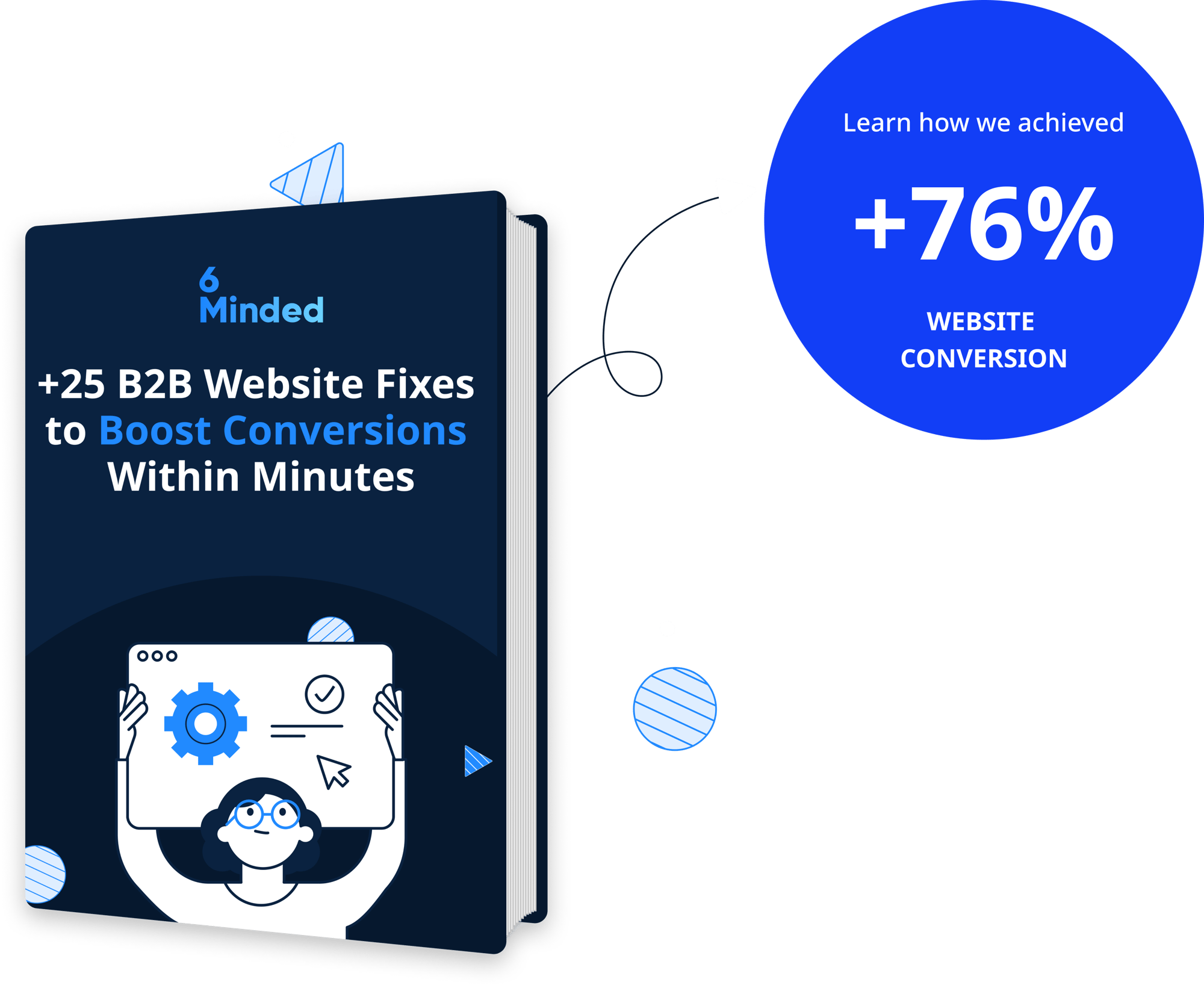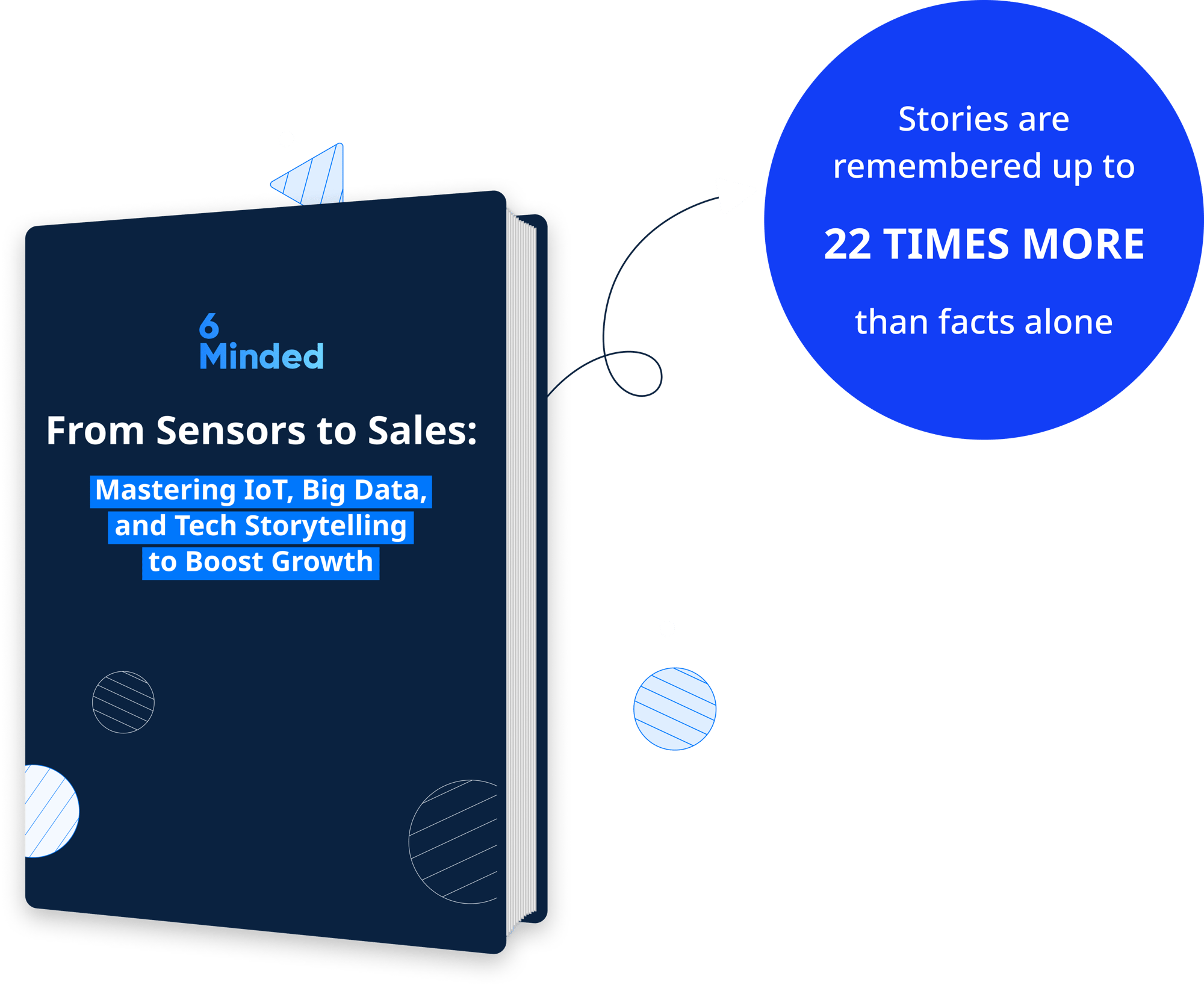Sipping on your favorite tea, taking several deep breaths, or cuddling with your pooch. What do these activities have in common? They are quick, effective, and free stress relievers that most of us will appreciate at this point in time.
Because let’s be honest; the start of the new year always comes with lots of stress when business opportunities arrive and there are more tasks than people to complete. With time deficiency, new year anxiety, and work piling up, you might think boosting SEO rankings is your lowest priority. The truth is, now’s the best time to think about it!
That’s precisely because getting your B2B business higher up the Google ladder will help you sail through 2023 stress-free and bring you peace of mind as no meditation would. And it doesn’t have to cost an arm and a leg. All you need to do to increase your chances of getting found online this year is apply a few simple SEO hacks we’ve laid down for you.
So, without further ado, look at these 9 SEO tips for small businesses and see how you can quickly optimize your website for better search results.
9 Express SEO tips for small businesses
3. Build a structure for featured snippets
5. Focus on the right keywords
6. Say ‘Hi’ to a mobile-friendly design
9. Get backlinks that establish authority
Benefits of website optimization
But why would you even trouble yourself with your SEO rankings when you seem to be doing OK? If your service or product checks all the boxes, there’s nothing to worry about, right? Right?!
Well, not exactly.
While it’s essential to ensure your offer delivers on your customers’ expectations, you still need to help them find you. And there is no better way to do so than to build a website with SEO in mind. Since 75% of users don’t look further than the first page of search engines, competing for the top results is a no-brainer. Higher SEO rankings make your website more visible to users, bringing more traffic and increasing your chance of converting leads to actual customers.
‘If it’s not on the first page of Google, then it doesn’t exist’ should be the ultimate Rule of the Internet.
However, don’t stress too much because we’re here to give you a few easy ideas to conquer search engines.
1. Conduct a content audit
Before you start producing new content, working with what you already have is a low-hanging fruit. Review pages published over six months ago and decide which ones could use a little boost. Users are not the only ones who like fresh, informative content. Google algorithm likes it too and tends to reward up-to-date results. Fortunately, that doesn’t mean favored content has to be new. All it needs is a few updates.
Recently, we took one of our high-potential blog posts and gave it a vast makeover, enriching it with new images, adding updated information, and making it more transparent. We promise you can do the same, and you won’t have to spend days on it! (Or, leave it to us if you have no idea where to start).
- Format your pages for a better user experience. Even though longer content drives almost four times more traffic than shorter, extensive blocks of text can scare your readers instantly. Try to stay within five sentences per paragraph, and keep your sections divided neatly by header tags and subheadings. And remember to throw bold, italic, and underline here and there!
- Leverage visuals. Did you know that the human brain processes images 60.000 times faster than text? No wonder visual content plays a big part in every marketing strategy. Use it to your advantage! Images relevant to your page’s topic effectively keep your visitors engaged and increase your dwell time factor, which is vital for SEO rankings.
[Source: Infogram]
Need more stats to get you convinced? Consider this:
- You have a 53% more chance of securing top search results once you embed a video on your page.
- 91% of consumers prefer visual content over text-based.
- Blog articles with infographics generate even 178% more inbound links than other posts.
Don’t forget to optimize the visual aspects of your entire website, keeping in mind recent design trends. Instead of cluttering it with too much content of any kind, opt for clean and easy-to-navigate architecture. This way, you'll make your readers' experience more enjoyable and return-worthy.
2. Cut down on load time
Remember that dwell time factor we mentioned above? It determines the time a user spends on a website before returning to SERPs (Search Engine Results Page). It’s an essential metric to be aware of. But this doesn’t mean you want your visitors to dwell on your website forever because of the load issues!
You want your potential customers to stick around for the right reasons and not due to poor website performance. The ideal load time for conversion rates is 0-4 seconds. Want to know what yours is? You can use a free online tool, like Pingdom, to find out.
[Source: Portent]
If you scored anything above 4 seconds, stay calm. You can do a few things to change that:
- Ensure all images are in the suitable file format and size. Compressing them can improve your load time instantly.
- Optimize your code, as removing unnecessary symbols and notations can be very effective. To handle the process of minification, you can follow Google’s recommendations.
- Follow the rule of clean design and eliminate needless elements slowing down your website.
- Use a good CDN (content delivery network), which saves multiple copies of your pages in different locations, ensuring an optimal load time for users worldwide. Some CMSs (including HubSpot) provide this service, and as a certified HubSpot Diamond Partner, we can assist your B2B business with website optimization.
3. Build a structure for featured snippets
Getting your content inside featured snippets is a great way to increase your website’s CTR and credibility. It gives you a chance to rank on the very top of SERPs (even above the no.1 ranking), and there are four different snippets you can aim for.
Lists showing bulleted lists of items.
Paragraphs in the form of answers and definitions providing information on a certain topic.
Tables visualizing different types of data and comparisons.
Videos pulled from YouTube, which often answer ‘how-to’ searches.
To rank your content for featured snippets, you have to:
- Use relevant keywords aligned with users’ queries.
- Organize your page with headings and subheadings.
- Keep your content simple, short, and easy to read.
4. Upgrade your images
You already know images are your not-so-secret weapon when it comes to engaging your audience. Now let’s optimize them for maximum SEO efforts:
- First, make sure each image is compatible with your page content.
- Ensure your visuals display properly on desktop and mobile.
- Add appropriate image titles, alt tags, and file names.
- Double-check if you have the rights to use the visual content you plan on adding.
- Create as much original content as possible. Personalized photos and graphics are always more interesting than redundant stock images.
5. Focus on the right keywords
Keywords are the backbone of your marketing, so naturally, you’ll want to include them on your website. But don’t go too overboard. Stuffing content with the most searched terms was a popular practice back in the day, but now it will get you a penalty from Google and drop your page’s search results.
Create engaging, informative, and user-friendly content and fit appropriate keywords to make it sound natural and spam-free.
There are three categories of keywords: head terms, medium-tail, and long-tail. While the first category are the most searched phrases, they are also highly competitive. It’s best to build your pages around long-tail phrases with low KD (Keyword Difficulty) that are easier to target. Look at the difference in keyword searches in Semrush:
Looking at the MSV (Monthly Search Volume) of the ‘software development’ keyword’, you could say it’s a perfect choice for an IT business. But the KD rating tells you it will be challenging to rank high for that keyword.
Now, let’s brainstorm some other ideas. ‘Online software solutions’ is far less competitive and gives a smaller B2B business a chance to rank higher in SERPs.
Put together a list of key phrases describing your product or service, and use them to answer your potential customers’ questions. You can use Google to find what they’re looking for by reviewing the ‘People also ask’ section.
You can use phrases from Google’s ‘Related searches’ section if you need more keyword inspiration.
Something that often gets overlooked is the website’s description visible on the search result page. It’s a little sneak-peak into your page, so make sure it looks clean and appealing to readers. Write descriptive meta titles, meta descriptions, and URLs that include your main keyword and don’t get cut off due to character limits.
6. Say ‘Hi’ to a mobile-friendly design
When building a website with SEO in mind, you should focus on the mobile first and the desktop second. Simply because most people use mobile to surf the web, you can check the mobile-friendliness of your website using tools like Website Grader or Google’s Mobile-Friendly Test, but it’s beneficial to check a few more boxes to make sure you’re all set:
- Improve your mobile website’s load time not to discourage your potential customers.
- Update all clickable elements so they’re visible and easy to tap with a finger.
- Propose an easily scannable structure with clear headings and attractive visuals.
[Source: Think with Google]
7. Go local
You will benefit greatly from setting up your Google Business account if you operate in your local area. It will make you look professional, let you control and update your business information and help customers find you, literally!
Add your contact information, address, and directions, include photos showing your unique personality, and interact with customers responding to reviews and answering common questions.
8. Check your links
Linking is one of the most important Google ranking factors. High-quality outbound links leading to authoritative data sources increase your website’s credibility. Remember to look for trustworthy and recent resources to let the SEO magic work.
Internal links, on the other hand, take readers to another page on the same website. They help users navigate your website, find helpful information, and keep them engaged for longer.
Be sure to fix any broken links that may no longer point to relevant sources. It crashes your SEO efforts and looks unprofessional. Use free tools like Dead Link Checking Tool by Ahrefs or Dead Link Checker to see where the problem lies.
9. Get backlinks that establish authority
Once you optimize your content using the tips above, consider getting backlinks. When others link to your content, it boosts traffic to your website from referral sites, establishes your website as an authority, and triggers SEO algorithms to improve your rankings.
[Source: Backlinko]
There’s an abundance of backlink-building strategies, but here are a few to get you started:
- Create excellent and shareable content, so others want to use it on their websites.
- Find your unlinked brand mentions and turn them into backlinks. You can do that manually using Google search or automatically with tools like Brand24 and BuzzSumo. Then reach out to the author of the article leading to your page and ask them to include your link.
- Identify broken links on different websites and suggest replacing them with your content. Tools like Semrush Site Audit can help you with that.
[Source: Semrush]
- Look for active and popular websites within your industry that accept guest blog posts and propose them a killer article idea to promote your own content.
- Answer journalists’ requests and get featured as a source in their articles. Help a Reporter Out is a great place to find collaboration opportunities.

9 SEO tips for small businesses–Try them yourself
Are you feeling relaxed yet?
Was it the tea or the idea of a hustle-free increase in your website traffic?
We hope our SEO tips for small businesses will let you secure a high spot in ranking results and make your business stand out from the competition.
And if there are still SEO-related concerns preventing you from reaching a Zen state of mind, share them with us! We’ll be sure to find quick and seamless answers to your marketing problems.



 September 2023
September 2023
